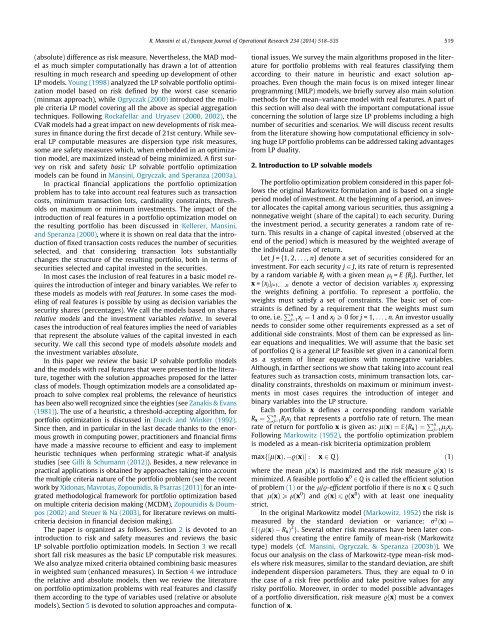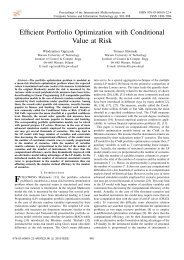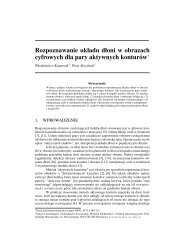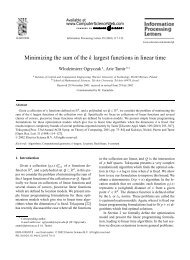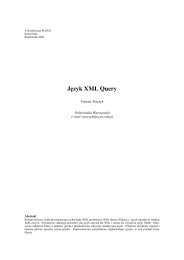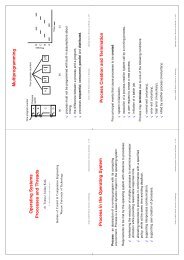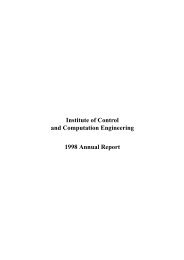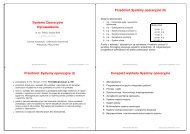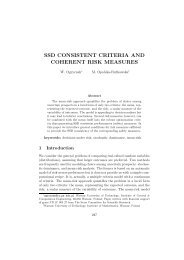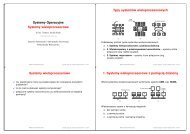Twenty Years of Linear Programming Based Portfolio Optimization
Twenty Years of Linear Programming Based Portfolio Optimization
Twenty Years of Linear Programming Based Portfolio Optimization
You also want an ePaper? Increase the reach of your titles
YUMPU automatically turns print PDFs into web optimized ePapers that Google loves.
R. Mansini et al. / European Journal <strong>of</strong> Operational Research 234 (2014) 518–535 519<br />
(absolute) difference as risk measure. Nevertheless, the MAD model<br />
as much simpler computationally has drawn a lot <strong>of</strong> attention<br />
resulting in much research and speeding up development <strong>of</strong> other<br />
LP models. Young (1998) analyzed the LP solvable portfolio optimization<br />
model based on risk defined by the worst case scenario<br />
(minmax approach), while Ogryczak (2000) introduced the multiple<br />
criteria LP model covering all the above as special aggregation<br />
techniques. Following Rockafellar and Uryasev (2000, 2002), the<br />
CVaR models had a great impact on new developments <strong>of</strong> risk measures<br />
in finance during the first decade <strong>of</strong> 21st century. While several<br />
LP computable measures are dispersion type risk measures,<br />
some are safety measures which, when embedded in an optimization<br />
model, are maximized instead <strong>of</strong> being minimized. A first survey<br />
on risk and safety basic LP solvable portfolio optimization<br />
models can be found in Mansini, Ogryczak, and Speranza (2003a).<br />
In practical financial applications the portfolio optimization<br />
problem has to take into account real features such as transaction<br />
costs, minimum transaction lots, cardinality constraints, thresholds<br />
on maximum or minimum investments. The impact <strong>of</strong> the<br />
introduction <strong>of</strong> real features in a portfolio optimization model on<br />
the resulting portfolio has been discussed in Kellerer, Mansini,<br />
and Speranza (2000), where it is shown on real data that the introduction<br />
<strong>of</strong> fixed transaction costs reduces the number <strong>of</strong> securities<br />
selected, and that considering transaction lots substantially<br />
changes the structure <strong>of</strong> the resulting portfolio, both in terms <strong>of</strong><br />
securities selected and capital invested in the securities.<br />
In most cases the inclusion <strong>of</strong> real features in a basic model requires<br />
the introduction <strong>of</strong> integer and binary variables. We refer to<br />
these models as models with real features. In some cases the modeling<br />
<strong>of</strong> real features is possible by using as decision variables the<br />
security shares (percentages). We call the models based on shares<br />
relative models and the investment variables relative. In several<br />
cases the introduction <strong>of</strong> real features implies the need <strong>of</strong> variables<br />
that represent the absolute values <strong>of</strong> the capital invested in each<br />
security. We call this second type <strong>of</strong> models absolute models and<br />
the investment variables absolute.<br />
In this paper we review the basic LP solvable portfolio models<br />
and the models with real features that were presented in the literature,<br />
together with the solution approaches proposed for the latter<br />
class <strong>of</strong> models. Though optimization models are a consolidated approach<br />
to solve complex real problems, the relevance <strong>of</strong> heuristics<br />
has been also well recognized since the eighties (see Zanakis & Evans<br />
(1981)). The use <strong>of</strong> a heuristic, a threshold-accepting algorithm, for<br />
portfolio optimization is discussed in Dueck and Winker (1992).<br />
Since then, and in particular in the last decade thanks to the enormous<br />
growth in computing power, practitioners and financial firms<br />
have made a massive recourse to efficient and easy to implement<br />
heuristic techniques when performing strategic what-if analysis<br />
studies (see Gilli & Schumann (2012)). Besides, a new relevance in<br />
practical applications is obtained by approaches taking into account<br />
the multiple criteria nature <strong>of</strong> the portfolio problem (see the recent<br />
work by Xidonas, Mavrotas, Zopounidis, & Psarras (2011) for an integrated<br />
methodological framework for portfolio optimization based<br />
on multiple criteria decision making (MCDM), Zopounidis & Doumpos<br />
(2002) and Steuer & Na (2003), for literature reviews on multicriteria<br />
decision in financial decision making).<br />
The paper is organized as follows. Section 2 is devoted to an<br />
introduction to risk and safety measures and reviews the basic<br />
LP solvable portfolio optimization models. In Section 3 we recall<br />
short fall risk measures as the basic LP computable risk measures.<br />
We also analyze mixed criteria obtained combining basic measures<br />
in weighted sum (enhanced measures). In Section 4 we introduce<br />
the relative and absolute models, then we review the literature<br />
on portfolio optimization problems with real features and classify<br />
them according to the type <strong>of</strong> variables used (relative or absolute<br />
models). Section 5 is devoted to solution approaches and computational<br />
issues. We survey the main algorithms proposed in the literature<br />
for portfolio problems with real features classifying them<br />
according to their nature in heuristic and exact solution approaches.<br />
Even though the main focus is on mixed integer linear<br />
programming (MILP) models, we briefly survey also main solution<br />
methods for the mean–variance model with real features. A part <strong>of</strong><br />
this section will also deal with the important computational issue<br />
concerning the solution <strong>of</strong> large size LP problems including a high<br />
number <strong>of</strong> securities and scenarios. We will discuss recent results<br />
from the literature showing how computational efficiency in solving<br />
huge LP portfolio problems can be addressed taking advantages<br />
from LP duality.<br />
2. Introduction to LP solvable models<br />
The portfolio optimization problem considered in this paper follows<br />
the original Markowitz formulation and is based on a single<br />
period model <strong>of</strong> investment. At the beginning <strong>of</strong> a period, an investor<br />
allocates the capital among various securities, thus assigning a<br />
nonnegative weight (share <strong>of</strong> the capital) to each security. During<br />
the investment period, a security generates a random rate <strong>of</strong> return.<br />
This results in a change <strong>of</strong> capital invested (observed at the<br />
end <strong>of</strong> the period) which is measured by the weighted average <strong>of</strong><br />
the individual rates <strong>of</strong> return.<br />
Let J = {1, 2, ..., n} denote a set <strong>of</strong> securities considered for an<br />
investment. For each security j 2 J, its rate <strong>of</strong> return is represented<br />
by a random variable R j with a given mean l j = E{R j }. Further, let<br />
x =(x j ) j=1,...,n denote a vector <strong>of</strong> decision variables x j expressing<br />
the weights defining a portfolio. To represent a portfolio, the<br />
weights must satisfy a set <strong>of</strong> constraints. The basic set <strong>of</strong> constraints<br />
is defined by a requirement that the weights must sum<br />
to one, i.e. P n<br />
j¼1 x j ¼ 1 and x j P 0 for j =1,..., n. An investor usually<br />
needs to consider some other requirements expressed as a set <strong>of</strong><br />
additional side constraints. Most <strong>of</strong> them can be expressed as linear<br />
equations and inequalities. We will assume that the basic set<br />
<strong>of</strong> portfolios Q is a general LP feasible set given in a canonical form<br />
as a system <strong>of</strong> linear equations with nonnegative variables.<br />
Although, in farther sections we show that taking into account real<br />
features such as transaction costs, minimum transaction lots, cardinality<br />
constraints, thresholds on maximum or minimum investments<br />
in most cases requires the introduction <strong>of</strong> integer and<br />
binary variables into the LP structure.<br />
Each portfolio x defines a corresponding random variable<br />
R x ¼ P n<br />
j¼1 R jx j that represents a portfolio rate <strong>of</strong> return. The mean<br />
rate <strong>of</strong> return for portfolio x is given as: lðxÞ ¼EfR x g¼ P n<br />
j¼1l j<br />
x j .<br />
Following Markowitz (1952), the portfolio optimization problem<br />
is modeled as a mean-risk bicriteria optimization problem<br />
maxf½lðxÞ; .ðxÞŠ : x 2 Qg ð1Þ<br />
where the mean l(x) is maximized and the risk measure .(x) is<br />
minimized. A feasible portfolio x 0 2 Q is called the efficient solution<br />
<strong>of</strong> problem (1) or the l/.-efficient portfolio if there is no x 2 Q such<br />
that l(x) P l(x 0 ) and .(x) 6 .(x 0 ) with at least one inequality<br />
strict.<br />
In the original Markowitz model (Markowitz, 1952) the risk is<br />
measured by the standard deviation or variance: r 2 ðxÞ ¼<br />
EfðlðxÞ R x Þ 2 g. Several other risk measures have been later considered<br />
thus creating the entire family <strong>of</strong> mean-risk (Markowitz<br />
type) models (cf. Mansini, Ogryczak, & Speranza (2003b)). We<br />
focus our analysis on the class <strong>of</strong> Markowitz-type mean-risk models<br />
where risk measures, similar to the standard deviation, are shift<br />
independent dispersion parameters. Thus, they are equal to 0 in<br />
the case <strong>of</strong> a risk free portfolio and take positive values for any<br />
risky portfolio. Moreover, in order to model possible advantages<br />
<strong>of</strong> a portfolio diversification, risk measure .(x) must be a convex<br />
function <strong>of</strong> x.


